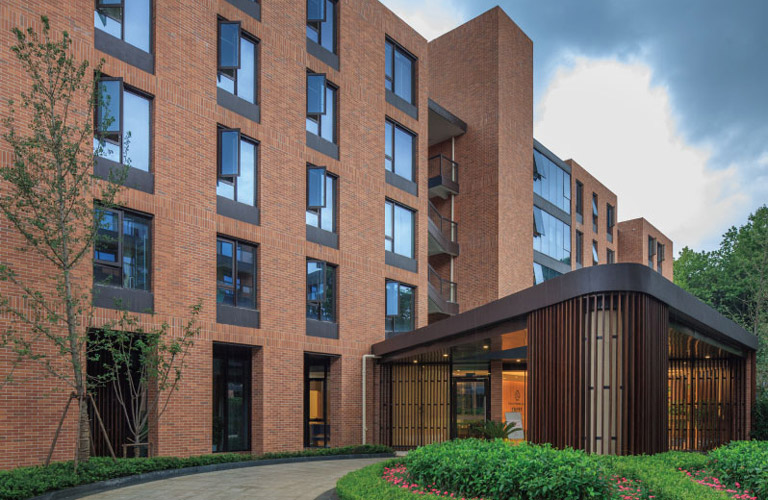



尊敬的女士们先生们,非常感谢丹麦驻沪领馆提供这次与各位交流的机会。
Ladies and gentlemen, first of all, thank Danish Consulate to provide this opportunity to share our experience with each other.
今天我演讲的主题是:中国养老住宅设计实践。我将和各位一起探讨中国养老住宅的产业背景,中国养老住宅的类型,以及中国养老住宅的特殊性。由于时间原因,我无法对每一点详细展开论述,希望各位谅解,同时希望能在接下来的讨论环节里能和各位进一步交流。
The theme of my speech today: Design for senior Living in China. I will try to explore the Background, Types and particularity of Chinese senior housing.
Time reason, I cannot be on every detail, so hope for your understanding. We can exchange our ideas in the next discussion session.
背景 Background
今年三月份和五月份,史无前例的在中国上映了两部有关老年人题材,而且都是有关机构养老背景的电影,而且都获得了巨大的社会反响和票房成功,其中一部“桃姐”还在戛纳电影节上获得了奖项。养老问题终于从政界,学术界的持续讨论,走进了公众的视野。
This year in China, many people swam to cinema, just to see two movies. Both of them are about senior living in China. One film named “the simple life” even won the Cannes Film Festival awards of the best actress. Finally, the Pension problem went into the public eyes, from the political and academic discussion.
由于中国特殊的国情,特别是在计划生育政策和户籍管理政策带来的持续影响下,中国的人口老龄化进程呈现以下几个当今学术界公认的特征:老龄人口规模巨大;老龄化速度快,而且阶段性不平衡;老龄化程度在空间分布上不平衡;老龄化先于现代化。
Because of the special situation in China, especially in the continuing impact of the family planning policy and household registration policies, China's population aging process presents several particularities: The huge scale of the elderly population, Aging speed very fast and unbalanced, Regional distribution unbalanced and aging before modernization.
在这种历史条件下,现今的中国养老机构的床位呈现总体的短缺。“中国经济周刊”发表专题“住不起的养老院”,向社会展示了北京养老院的生存现状。虽然在政府的大力推动之下,养老床位数呈现了大幅增长,但还是出现“公立养老院住不进,私立养老院住不起”的现象。
In such historical conditions, it was felt that shortage of beds in Chinese pension institution was socially and economically undesirable. In July of this year, "China Economic Weekly" published a feature article named "cannot afford to live in nursing houses", it shows us the outline of the survival status of the nursing home in Beijing. Although powerful impetus of the government, number of beds in nursing houses presents a significant growth, but for many people, it is still difficult to get a bed in public nursing houses, and expensive to live in private nursing houses .
类型 Types
在去年的一次演讲中,针对当今中国以房地产开发企业为主导的民办养老机构现状,我提出了一个对于中国老年公寓类型学的研究模型。从养老物业的区域位置(市区型,郊区型,景区型),与普通住宅区的关系(专属型,嵌入型,混合型),盈利模式(持有型,持有+ 销售型,销售型),这三个维度展开系统分析。
In a speech last year, I proposed a research model on the typology of private senior housing in China. There are three dimensions, the Location (Urban, Suburban or Scenic), the relationship to uptown (exclusive, embedded or mixed), profit model ( hold, sell or hold + sell).
作为案例,选取的是几个我们设计的典型的养老社区:
As case study, I selected several typical projects from us:
一个是位于海南省的养老社区。5万平米的健康老人公寓嵌入在总量50万平米的旅游度假类的住宅社区中。其中2.5万平米持有,剩余2.5万平米销售。余下的45万平米住宅都考虑适老化设计。
The first one is a project in Hainan Province. Apartments for independent living with 50,000 square meters floor area, embedded in a resort community. 25,000 square meters floor area will be hold from the developer; other 25,000 square meter floor area will be sold. The normal apartments in the resort community are all designed as elderly orientated housing.
第二个是位于上海市郊的一个成熟住宅社区里的健康老人公寓。总面积1.3万平米,120套老人套房全部由业主持有。
The second project is an apartment building for independent living with 13,000 square meters floor area in a mature residential community located in the suburbs of Shanghai. 120 Apartments are hold from the developer.
第三个是一个位于北京城市中心区的改建类项目。面积正好也在1.3 万平米左右。
The third one is a reconstruction project, located in the urban area of Beijing. The total floor area is also 13,000 square meters.
第四个项目也是位于上海郊区,但总面积合计11.2 万平米,是一个大型的CCRC社区。
The last one is a big CCRC Community with 112,000 square meters, located in the suburbs of Shanghai.
差异Differences
最后我简单介绍一下中国老年住宅设计的一些特殊性。
Finally, I briefly introduce you some of the special characters of the Chinese elderly residential design.
由于中国老年人生理机能,居住习惯,生活经历,价值理念的特殊性,以及中国社会从保障体系,道德观念,经济基础,到政策环境的特殊性,造就了中国老年住宅与其它国家老年住宅许多方面的不同。
Because of the different Physiological function, Living habits, Life experiences and outlook of value of Chinese elderly, as well as the specification of social welfare system, Moral Reasoning, economic basis and policy environment of Chinese society, Chinese elderly residential holds out many characters different from other coutries.
比如朝向问题,中国大部分地区的老人还是喜欢尽量朝南。对于西向,特别是北向的房间具有较大的抗性。这种对于单一朝向的偏好对建筑体形布局的多样性提出了挑战。
For example, Let us talk about the Orientation of buildings. In most parts of China, the elderly still prefer their room faces south. But for the west, especially north oriented rooms, they have a greater resistance to. This preference for single orientation presents us a challenge to the diversity of building floor layout.
还有户型问题。中国人特殊的烹饪习惯提出了对于厨房布置的特殊要求,甚至许多南方地区老人对于风水学的崇拜也一定程度上改变了室内功能的布局。
Another problem is about dwelling spaces. Chinese cooking habits Particular requirements for a special kitchen layout. In southern China, many elderly are superstitious in feng shui theory. This also leads to some change of the interior functions layout.
当然还有室内装修风格问题。当我们在设计中越来越抵制统一的制度化空间,注重体现对老年人过往生活记忆的延续,着重营造普通居家的生活气氛时,在室内设计中必然呈现出多样性和特殊性。
Of course, there is another issue about interior style. Interior design for elderly must pay attention to reflect a continuation of past life memories of the elderly when we resist the institutionalized space, and focus to create an atmosphere of ordinary home life. This will become an important source of diversity and particularity of interior design.
我的演讲到此结束,谢谢各位。
That’s all. Thank you for your attention.